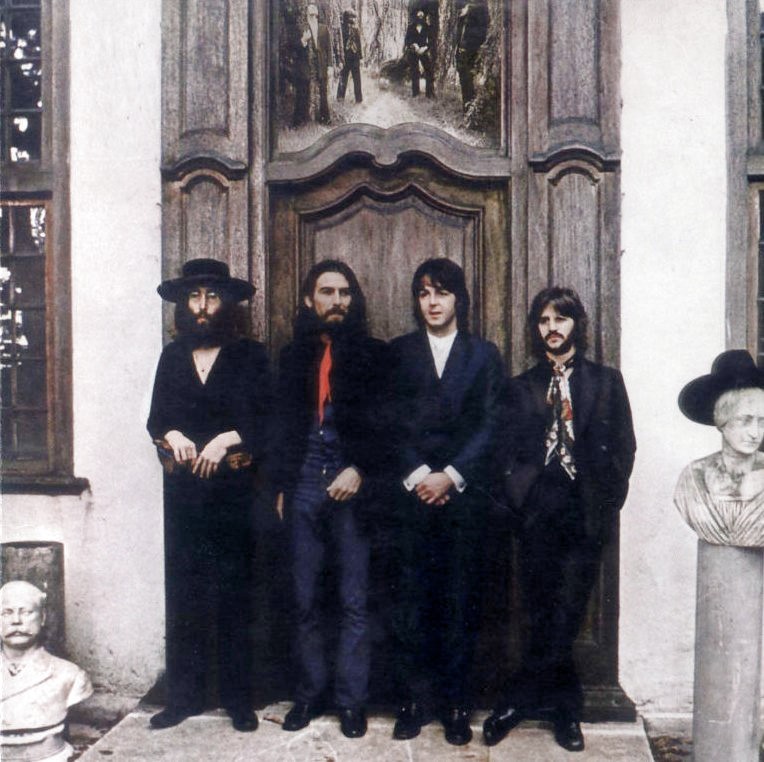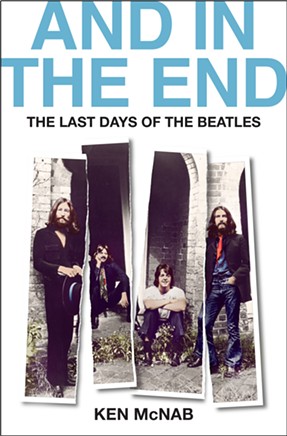And In the End: The Last Days of the Beatles
By Ken McNab
320 pp.
$28.99
Thomas Dunne Books
By the summer of 1969, the finely-tuned motorcar that was the Beatles was nearing “E” on its collective gas tank. There was a grimness that had fallen over their company (Apple), the recording studio (Abbey Road), and in their own interpersonal relations.
But on the afternoon of August 22, they still had one more job to do as a group. Two days earlier, they had completed recording on what would be their final chronologically-recorded album, named after the studio in which they had put down most of their music. But new product also required new publicity photos, so the four (along with two of their wives) came together at John and Yoko’s Tittenhurst Park estate, as photographers Ethan Russell and Monte Fresco began snapping away.
The photos of the four hirsute, darkly-dressed musicians could not telegraph more discomfort and resignation. And the Fabs annus horribilis of 1969 wouldn’t stop when the last shutter clicked. In this valuable addition to the Beatles Bookshelf, author Ken McNab takes a detailed and deep dive into the last year of the band’s existence, and manages to uncover some choice new info about the likely most written-about band in the history of music.
One thing is for certain, known for a long time by Beatle fanatics but somehow still not permeating much of the general public: Yoko Ono did not break up the Beatles. Sure, she was a contributing factor. And irksome for the other three members to have her presence there constantly in the studio and business meetings, with she and Lennon seemingly joined at the hip.
And it was beyond the pale when during the first days of recording for Abbey Road, Paul, George, and Ringo watched with mouths open as a fully-equipped hospital bed from Harrod’s carrying Ono – recovering from a family car wreck which also delayed Lennon’s arrival – into the studio. The couple also had a microphone installed over the prone Ono so she could offer commentary and advice on the music. Oh, and she was pregnant at the time, when both Lennons were also addicted to heroin.
But by those sessions, the end was near. Business problems and arguments over money and contracts and who would represent them – Allen Klein (per George, John, and Ringo) or Lee Eastman (per Paul) drained any sense of camaraderie. And each Beatle was already well on their ways to new paths: Lennon to Ono-fueled avant-garde projects, Harrison chafing to have his own songs be heard as a solo artist, and Starr venturing into film. Even McCartney – always the group’s biggest cheerleader and motivator, even when he became a bit overbearing – was ready to throw in the towel.
As McNab notes, it was Lennon who first said he was quitting for good (earlier departures by Starr and Harrison were quickly smoothed over), but the band agreed not to say anything during continuing contract negotiations about publishing and recording and royalties.
Still, it was bizarre that almost no one picked up on McCartney’s quote from a November 1969 Life magazine: “The Beatle thing is over,” and moreso when he released a “self-interview” as part of his first solo record amplifying the band wouldn’t be working together again. Furious, Lennon wanted to be the first to break the news, since he saw the Beatles as his band.
McNab covers some familiar ground and stories, but putting them all in chronological order is a boon for fans. He also wonderfully locates some people who had encounters with band members during that year, many of which have either never or rarely been interviewed in other Beatles books.
They include Lennon’s cousin, who saw John, Yoko, and their respective children Julian and Kyoko during that fateful Scotland motoring trip to visit relatives (the same one they’d be injured in). There’s also painter/decorator Derek Seagrove, who inadvertently appears on the cover of Abbey Road in the background with a couple of other workers. And engineer Andre Perry, who had to hustle recording equipment into the Lennon’s Montreal hotel bedroom to record “Give Peace a Chance.” Even the studio employee who had to run out and purchase three pairs of ladies pantyhose to put over the microphones for the famous Let It Be rooftop concert - because the high wind would ruin recording!
There’s even one tantalizing musical fact: At one point, as McCartney was running from the “Paul is Dead” mania, Jimi Hendrix sent a telegram to the Apple offices inviting McCartney to play bass on a weekend jam session with jazz legends Miles Davis and drummer Tony Williams that might have led to something more. McCartney never saw the last-minute invite, and who knows what could have resulted from that?
And In the End is one of a number of Beatles media which focus on the timeframe where the band ended. Most anticipated is Director Peter Jackson’s new “recut” of the Let it Be documentary. While the original film (the only Beatles movie that has never re-released or issued on home video) was a dismal chronicle of a band in crisis with their music and each other, Jackson’s version shows a more positive take (and with 200+ hours of footage filmed, it could have also made several other docs).
Still, reading And In the End is somewhat akin to a book about the maiden voyage of the Titanic or the theater-going habits of Abraham Lincoln: You know the end is coming, you know what the result is, and there’s not a damn thing the reader can do to stop it. Like a lot of bands, the end for the Beatles wasn’t pretty. But unlike a lot of other bands, a lot of people still care – and obsess – over the events.
Support Us
Houston's independent source of
local news and culture
account
- Welcome,
Insider - Login
- My Account
- My Newsletters
- Contribute
- Contact Us
New Book Digs Deep on the Bitter End of the Beatles

Apple/Capitol records cover
The cover of the U.S. 'Hey Jude" album compilation features a photo from the last-ever Beatles group photo session. An splendid time was NOT guaranteed by all.
[
{
"name": "Related Stories / Support Us Combo",
"component": "11591218",
"insertPoint": "4",
"requiredCountToDisplay": "4"
},{
"name": "Air - Billboard - Inline Content",
"component": "11591214",
"insertPoint": "2/3",
"requiredCountToDisplay": "7"
},{
"name": "R1 - Beta - Mobile Only",
"component": "12287027",
"insertPoint": "8",
"requiredCountToDisplay": "8"
},{
"name": "Air - MediumRectangle - Inline Content - Mobile Display Size 2",
"component": "11591215",
"insertPoint": "12",
"requiredCountToDisplay": "12"
},{
"name": "Air - MediumRectangle - Inline Content - Mobile Display Size 2",
"component": "11591215",
"insertPoint": "4th",
"startingPoint": "16",
"requiredCountToDisplay": "12"
}
,{
"name": "RevContent - In Article",
"component": "12527128",
"insertPoint": "3/5",
"requiredCountToDisplay": "5"
}
]


